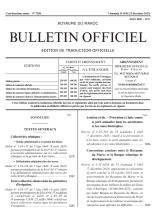Land Library
Bem-vindo à Biblioteca do Land Portal. Explore nossa vasta coleção de recursos de acesso aberto (mais de 74.000), incluindo relatórios, artigos de revistas científicas, trabalhos de pesquisa, publicações revisadas por pares, documentos jurídicos, vídeos e muito mais.
/ library resources
Showing items 1 through 9 of 42.This study addresses the significant issue of land fragmentation in Ethiopia, which is characterized by small, irregular, scattered parcels with no or adequate road access.
Dahir n° 1-19-117 du 7 hija 1440 (9 août 2019) portant promulgation de la loi n° 64-17 modifiant et complétant le dahir n° 1- 69-30 du 10 joumada I 1389 (25 juillet 1969) relatif aux terres collectives situées dans les périmètres d’irrigation
Este año el informe presta especial atención al impacto del agronegocio en cuatro dimensiones: la alimentación, la salud, el cambio climático y la criminalización.
Desde 2018 se ha cuatriplicado la cantidad de personas que pasan hambre en Centroamérica, donde hoy 7.3 millones de personas se encuentran en esa situación. Escucha este adelanto del segundo #podcast de la serie Centroamérica Resiste junto a Expediente Público de Nicaragua.
With around 7.4 million inhabitants, Laos is relatively sparsely populated. Over 70% of Laotians depend directly or indirectly on agriculture and forestry for their living.
Iron deficiency anemia (IDA) affects more than 3.5 people in the developing world. More than half of pregnant women (56 percent) and 44 percent of nonpregnant women are anemic (ACC/SCN 2000).
This study examines the implications of gender differences in wealth transfers—farmland and education—on the lifetime incomes of men and women in the rural areas of Ghana, the Philippines, and Sumatra.
Before 1994 the policy of apartheid in South Africa had systematically denied the majority of the population access to resources through legal restrictions on mobility, property rights, and residential location (Thompson 1990).
The devolution of natural resource management responsibility from the state to communities or local user groups has become a widespread trend that cuts across countries and resource sectors.









